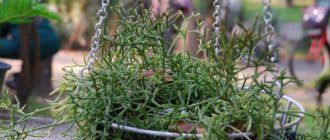- January 7, 2019
- Plant care
- Sergey Klimov
The home orchid is the favorite flower of any housewife who loves to do indoor gardening. Despite the fact that they are easy to care for, it is often these plants that make you think about whether it is possible to replant an orchid during flowering. Of course, here it is worth considering the type of flower, since most of them do not require replanting, but everything will depend, first of all, on the condition of the root system and the substrate in which the plant is planted.
Is it possible to replant flowering orchids: possible risks
An orchid is a flower that, with proper care, can bloom for a very long time.
During this period, she spends all her energy on the growth and formation of buds. Therefore, before you decide to transplant it, you need to weigh the pros and cons, evaluate the possible consequences of this procedure, and only then get to work. After replanting, the plant can shed all its flower stalks and unopened buds; the flowering period will be shortened; the new flowering shoot will slow down its formation or it may completely stop its growth and development. To prevent this from happening, you need to carefully study and strictly follow the instructions for transplanting flowering epiphytes.
Possible mistakes
Often after transplantation, plants begin to hurt. The latter is associated with damage to the roots. They begin to rot or dry out, and a fungus develops due to weakness. Without timely correction of care, the flower will die.
What to do if the orchid withers after transplantation
If a flower fades, you first need to determine the reason:
- mechanical damage to the root system;
- overwatering or lack of moisture;
- high concentration of fertilizers;
- poor aeration of the substrate, the roots “suffocate”;
- presence of pests;
- placement in a room that is too hot.
If there is a problem with the roots, place the flower in a cool, dark place for several hours, and then moisten it well by placing it in a container with warm filtered water. You can add a little fungicide. An insecticidal preparation that works according to the instructions on the package will help control pests. In other cases, the main thing is to restore the correct home care regimen, the flower will get stronger and will delight you with bright colors.
No flowering
If the orchid does not bloom, you should first make sure that there are enough roots and they have braided the entire substrate. Until then, the flower will continue to grow its underground part, directing all its energy to it. If everything is fine with the root system, it is worth stimulating the development of peduncles and the formation of buds. To do this, reduce watering, ensure daylight hours within 12 hours and do not feed the flower, especially with nitrogen-containing fertilizers.
Orchid is an exotic plant that grows well in city apartments. It is easy to care for if you replant it in time, without allowing the roots to rot due to the unsuitability of the substrate and dry out due to the tightness of the pot.
When should you replant an orchid? Reasons for transplant
Transplantation is stressful for any plant. The orchid endures this procedure especially painfully. But for healthy growth and beautiful buds this is necessary. There are planned and emergency transplants.
- planned - done every two to three years with the correct development of the plant. It is best to do this in the spring, when the orchid has rested and is gaining new strength for further growth. Reasons for a planned transplant may include replacing the soil or substrate for the flower; abundant growth of roots, small pot, dividing the plant into several pots.
The planned transplant procedure includes a number of conditions:
- You need to wait for the orchid to bloom. Otherwise, she will go through a long period of adaptation.
IMPORTANT! If this is not possible, but replanting is necessary, in this case the orchid is transferred to a new pot with old soil. This method is used when the pots urgently need to be replaced.
2. If a uniform green color of the roots is observed, this means that the root system is developing well. Here you need to wait until the young tips grow to 5 cm.
3. You should not replant the orchid immediately after purchase. It is necessary to allow the flower to adapt to new home conditions, which are significantly different from store ones. This takes on average 2 – 3 weeks.
- Emergency - performed only in extreme cases, if the plant is damaged by pests or diseases; rotting of the roots is observed when the soil is waterlogged or yellowed dried leaves of the plant; there is poor quality soil for growing orchids.
IMPORTANT! If the reason for replanting a blooming orchid is due to rotten, spoiled roots, in this case the entire flowering part must be cut off so that all the forces of the flower are spent on rooting.
Trimming the wilted peduncle
For each type of orchid, pruning methods differ. In phalaenopsis, the peduncle is partially removed. To do this, you need to wait until the petals have completely fallen. After withering, a peduncle remains. If you don’t cut it off, there may be several options that will determine what to do next with the orchid:
- when the peduncle has dried completely and darkened, it is removed;
- if there are buds left on the stem and the tip is green, you need to wait - buds may form;
- in case of incomplete drying of the stem, the waiting period is also extended: the arrow will deliver food, and then it will bloom again;
- if the stem is cut early, the flower will need several months to recover, then new buds will appear only after six months;
- if the buds are swollen, the cut is made 2 cm above their level.
Sympodial orchid species regularly renew their flowers themselves, so the shoot is not removed. These include dendrobium, oncidium, and cymbidium. In monopodial hybrids (Vanda, Doritis), the peduncle dries out along with the stem. It is removed at the base.
Orchid transplantation at different flowering periods
Transplanting an orchid at different flowering periods is characterized by its own characteristics.
During the appearance of the peduncle
Only emergency plant transplantation is carried out. In this case, the flower stalk is shortened or cut off to restore the flower as quickly as possible.
During the budding period
Transplanting an orchid into this is very dangerous. She can throw off all the buds and dry out the shoot. If this procedure is still necessary, certain rules should be followed:
- first moisten the substrate well to make it easier to remove the orchid from the pot;
- soaking the orchid roots in warm water for 20–30 minutes to gently remove the remnants of the old soil;
- completely remove rot and damage. Treat and disinfect the cut roots, dry;
- replant the blooming orchid into a new pot, strictly following the replanting instructions.
The final phase of orchid flowering
The final flowering phase is the most favorable time for replanting. It adapts faster to new conditions, gets sick less and begins to bloom faster.
Reproduction methods
It is important not only to understand how to care for a phalaenopsis orchid at home, but also how to properly propagate this plant. It is worth remembering that it is much more difficult to propagate than other varieties.
Phalaenopsis belongs to the monopodial type, that is, it has only one growth point. Material should be taken only from healthy plants that are not affected by rot, insects, or fungus. Reproduction can be carried out:
- children;
- cuttings;
- division.
Children are formed on the peduncle. They can be separated 1-2 months after the end of the flowering process. The formation of children is mainly characteristic of an orchid that is at least 2 years old. You can separate them immediately after the roots or at least 2 leaves appear.
The baby should be carefully cut, then the sections should be treated with charcoal powder and dried in a shaded, well-ventilated area. Fill disposable cups with soil that needs to be pre-moistened
Dilute Kornevin according to the instructions, dip the children in the prepared solution and place them in cups. Cover them with film and place in a bright, warm place. It is necessary to regularly moisten and ventilate. After a year, you can transplant the young plant into a pot.
You can also propagate by rooting the peduncle. No more than 2-3 months should pass from the moment of flowering. The peduncle needs to be cut off at the base, and the cuts should be treated with cinnamon or charcoal powder. The stump needs to be covered with beeswax. Cut each peduncle into several cuttings, leaving 1-2 buds on each. Moisten the moss with a growth stimulator and lay the resulting sections horizontally. Cover the container with film and keep warm in good light, maintaining sufficient humidity. Periodically you need to spray them with a stimulant for faster root formation. When the roots grow and the first leaves appear, the cuttings should be planted in separate pots.
How to properly replant a flowering orchid in case of diseases and pests?
One of the reasons for an emergency transplant of a flowering orchid may be infection of the plant with diseases and pests. In this case, the flower needs urgent help.
First, you need to assess the condition of the flower: carefully remove the orchid from the pot, clean the roots from the soil, rinse them in clean warm water and dry them well. Remove all diseased areas of the root system and throughout the plant, treat the sections with activated carbon. Before planting, treat the roots with special preparations against diseases and pests. After transplantation, the orchid must be regularly sprayed with the same preparations.
Against diseases, it is recommended to use drugs such as strobi, topaz, oxychom, hom, champion. Against pests - Actellik, Bona Forte, Aktara, Decis, BI-58, etc. The dosage and method of use are indicated on each product package.
IMPORTANT! Treatment of plants with drugs must be carried out in the fresh air using a respirator so that harmful substances do not enter the body through the respiratory tract.
Tips and tricks
Some tips will help you replant your orchid so that it continues to delight you with its flowering. So, after washing the roots from the old soil, they need to be dried for a long time, about 7 hours. Drainage can be not only expanded clay, but, for example, broken brick, but only crushed, and even pebbles.
If the orchid has already grown greatly, then it should be divided into two pots. After transplantation, such a plant should be cared for more carefully and thoroughly. It is always worth remembering that any transplant for an orchid is a lot of stress, so you should be careful and competent about this procedure.
If gardeners were wondering whether it is possible to replant an orchid when it is blooming, now they no longer face such a question.
Transplant instructions
- First you need to get the flower out of the old pot. Separate the soil from the walls of the container, cutting or breaking it if necessary. This is necessary when the roots of the plant can be damaged by pulling it out.
- Next, the orchid roots are freed from the old substrate and washed in warm water.
- At the next stage, it is necessary to remove all damaged and dried areas of the root system with scissors treated with alcohol. Sections must be treated with charcoal powder to protect plants from rot and disease.
- Then the plant needs to be dried for about 6 hours to remove all excess moisture. To make the process go faster, you can blot the orchid with paper towels.
- Drainage is placed at the bottom of the selected pot and sprinkled with fresh substrate. An orchid is placed on top. The pots are filled with the remaining substrate so that it lies tightly without forming large voids.
IMPORTANT! You should not plant orchids too deep, as this can lead to rotting of the young buds. But planting the plant too high can cause the pot to tip over and damage the stems.
Is it possible to disturb a flowering plant?
The flowering period is not the best time for replanting . The plant concentrates all its energy on growing flower stalks; the orchid’s energy may not be enough to adapt to new conditions. But in exceptional conditions, replanting will bring more benefit than harm to the plant.
Immediately after purchase in the store
A newly purchased orchid should be replanted in the following cases:
When the plant's pot is damaged or the walls of the container do not allow light to pass through.- If the roots are not visible in the container. Healthy roots are green, dry roots turn silver, other colors are signs of disease or rot. In this case, the orchid is immediately replanted.
- Store-bought substrate is often of low quality, with peat and foam rubber, which causes caking and promotes root rot. It is better to replace it during transplantation.
- Shriveled and pale roots are a sign that the plant has been treated with flowering stimulants. After purchase, such an orchid is replanted immediately.
We talked about the features of replanting an orchid after purchase in this article.
If it has been growing in your home for a long time
An orchid that has been growing at home for a long time is transplanted during flowering if:
- The plant looks sick or has pests.
- The roots of the flower have grown and do not fit into the pot.
- The substrate has compacted and accumulates a lot of water. IMPORTANT : In a pot, the tendency for the substrate to caking occurs in two cases - it is initially of poor quality or the flower is not properly cared for, for example, it is watered too much.
- The leaves turn yellow, become covered with dots and dry out.
- If the roots have grown into the walls of the clay pot.
- The leafy mass of the flower has become larger than the pot.
- Orchid roots rot in very humid environments.
In case of rotting, the orchid must be replanted immediately ; this condition is very dangerous for the flower. Many gardeners are wondering: is it worth doing this during flowering? Replanting a plant when it blooms should only be done as a last resort, but it is still better than watching it die.
Choosing a pot for an orchid
Transplanting a blooming orchid is a responsible undertaking. First of all, you need to choose the right pot so that the plant feels at home in it. When choosing a container for transplantation, it is important to follow the basic principles:
- transparent pot: participating in the process of photosynthesis, the roots of the plant need constant light;
- mandatory presence of drainage holes in the pots to prevent root rot;
- the size of the pot must correspond to the size of the flower: too large contributes to the growth of green mass, which is why there are fewer buds; too small will not allow the root system to fully develop and the plant will die;
- in a glass container, orchid roots lack oxygen, which negatively affects their development;
- In a ceramic container for an orchid, the internal cavity should be covered with glaze so that the roots do not stick and are not injured.
Plastic transparent flowerpots are a classic version of a container for replanting orchids. A gardener can easily observe the development of a plant, see whether it needs watering or whether it has any diseases or pests. In addition, there is free access of light to the roots, which is one of the conditions for healthy growth of the epiphyte.
Plastic planters have a good drainage system at the bottom. But if this is not enough, it is easy to make holes in the walls to provide more oxygen access.
For your information! If a plastic pot does not harmonize well with the overall interior, then you can choose a suitable large container and place a flower pot in it.
Clay containers for orchids in the form of vases and pots must be equipped with drainage holes. Fits well into the interior. Such pots retain moisture well and the root system does not overheat, but the rough inner surface can damage the roots of the plant.
Baskets are less practical, but add color to the interior. For them, it is recommended to use a substrate with a high content of moss and peat to retain moisture, since the soil in baskets dries out quickly.
A block crop is a piece of wooden natural material (part of thick branches, driftwood, etc.) with hooks on which they are hung. Its size depends on the root system of the orchid. Transplanting into block crops is a very labor-intensive process; you need to constantly ensure that the wood remains moist and spray it several times a day. For lovers of eco-interior, this is a very suitable option.
The most fashionable and modern type of container for transplanting flowering orchids can be called glass flowerpots or flasks , which are popular with designers. But due to the lack of oxygen and high humidity, the orchid will not live in it for long. In such an environment, various types of fungi and molds develop well. To extend the life of a flower, you need to ventilate its roots every time you water it, pulling it out of the vase. The most viable in such conditions are Vanda orchids.
IMPORTANT! Before transplanting an orchid, any pot must be washed thoroughly under running water using ordinary laundry soap and disinfected or treated with boiling water.
Capacities
For an epiphytic or lithophytic exotic pet, it is extremely important to create the best conditions for the root system
Therefore, special attention should be paid to the container in which the orchid will live.
Opaque or ceramic pot
The roots of most species are photosynthetic, which means they need good lighting. In addition, this most vulnerable part of the orchid needs constant monitoring. Transparent container allows:
- promptly notice symptoms of root rotting and poor soil conditions;
- assess the degree of substrate moisture.
Transparent pots allow you to observe the condition of the root system.
New pottery “breathes” well, does not overheat and maintains humidity levels. However, over time, the internal surfaces become greasy and lose these properties.
But the main danger lies in the rough, porous structure of the material: roots cling to it well and grow, which makes it difficult to separate them during transplantation and therefore threatens serious troubles.
Advice! Experienced gardeners know how to deal with the peculiarities of ceramic and opaque containers; they “feel” the plant. For beginners, it is better to choose traditional orchids - plastic, with smooth walls and transparent.
Glass flowerpot
Transparent glass flowerpots meet the requirements of illumination of the roots and the need for regular monitoring of the substrate. But they can’t cope with aeration.
Pots of orchids can be placed in a spacious glass vessel; Vandas with their long, abundant roots will be especially good in a tall vase.
Soil preparation
The next stage of transplanting flowering epiphytes is the selection and preparation of soil. The substrate for an orchid should be loose, breathable, and long decomposing. You can buy it in a store or prepare it yourself. It must contain pieces of bark, coal, moss, peat with the addition of mineral fertilizers. The ratio of these components depends on the growing conditions of orchids, humidity levels, and oxygen access to the root system.
When can a plant change its soil?
As mentioned earlier, after flowering, the flower is replanted in the spring . But how can a beginner determine that it’s time for an orchid to change the soil? There is a theory that the plant should not be touched for 2 years, and only after that is it ready for replanting. But you shouldn’t trust the standards unconditionally, since they are not the same for different species. There are practical examples by which you can accurately determine the time of transplantation:
- a powerful root system that has become cramped in the old pot;
- a large number of aerial roots are formed;
- the leaves began to become covered with pale green or yellow spots;
- the orchid does not produce a peduncle for more than three months from the moment of the last flowering;
- the volume of green mass is several times greater than the size of the pot.
But there are parameters that force the grower to transplant ahead of time.
Caring for an orchid after transplantation
The basic rule for caring for an orchid after transplantation is to create conditions for its rapid adaptation. During this period (about 3 weeks), you need to protect the flower pot from direct sunlight and drafts, assigning it a permanent place. The transplanted orchid should be kept in a room where the temperature is maintained at no more than 20-23°C and humidity 60-70%. A month after transplantation, the plant must be fed with complex fertilizer, and the first watering should be done 3 to 5 days after the above procedure with clean, settled water at room temperature. Between waterings, the plant can be sprayed a little.
Problems and difficulties
If you do everything correctly, then there will be no difficulties. If the plant is infected with parasites, it will have to be treated by dipping the roots in a special solution for 15 minutes. Also, during transplantation, rotting of the roots may be detected, which will have to be removed . If after transplantation you place a flower on a windowsill, it may get sick; the light should be diffused.
In our other articles you will learn how to care for an orchid after replanting and whether it is necessary to replant the plant after purchase.
Possible problems after transplantation
Following all the rules for replanting an orchid and caring for it will help the flower to quickly take root in a new place. Despite this, negative consequences can still occur.
After replanting, the orchid's leaves may turn yellow. This can be influenced by many reasons: poor ventilation of the root system, pests, poor microclimate in the room. Correct temperature and humidity will help get rid of this.
If the roots are injured or the soil is waterlogged, a general wilting of the bush is observed. In this case, it is necessary to adjust the microclimate in the room and carry out treatment against parasites.
If the temperature, watering and lighting conditions are not observed, the orchid may stop forming new flower stalks. To avoid this, it is necessary to improve lighting, exclude watering for 10 - 14 days, and feed the plant with succinic acid.
How to choose the right pot?
In order for the plant to develop normally, it is necessary to choose the right pot . A transparent pot is suitable for varieties of orchids in which the root system is involved in photosynthesis.
For normal water drainage, the flowerpot must have the required number of holes. You should not replant the plant into a very spacious container, as it will not bloom, but will grow green mass.
If a phalaenopsis orchid is transplanted into a ceramic pot, then the inside should be covered with glaze. This will prevent the roots from sticking to it and will help avoid injury. It is best not to purchase a glass flowerpot, since in such a container the root system will begin to suffer from a lack of oxygen.
The orchid pot should have a small stem . In this case, the air will circulate freely and the necessary outflow of water will occur.
When is the best time to move the plant?
If an orchid bought in a store is crowded in a pot, with numerous roots sticking out of it, then you can immediately move the flower to a larger pot. If you transplant the orchid carefully, without destroying the old earthen lump, then it will easily endure this procedure .
If you need to carry out the replanting process according to vital signs, then it is better to cut off the peduncle at the first dormant bud. The plant will spend energy on restoration and growth, and next time it will bloom more magnificently and beautifully.
We recommend watching a video about replanting an orchid after purchasing:
When can you do this at home?
There is no period for a blooming orchid when it is best to replant it . All the time - from the release of the arrow to the last flower - this is not shown unless there are some “BUTs”.
When the peduncle is formed, it is strictly not recommended to subject the orchid to stress.
There are situations when an urgent transplant is required:
- Any disease, regardless of its nature, requires a plant transplant.
- Problems with roots. If the root system of the plant begins to look unimportant, the roots dry out or turn black, then replanting cannot be avoided. Particular attention should be paid when the roots begin to rot. The peduncle must be carefully cut so that the plant takes root.
- Pest attack. It is impossible to cure a plant without replanting, and special means will not help here. They will only harm the roots, and it is almost impossible to remove pests from the substrate.
- The pot is small. A container filled with roots is also a sign of an urgent transplant. The roots displace the substrate, which is necessary for the normal life of the plant.











